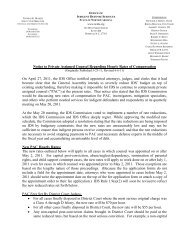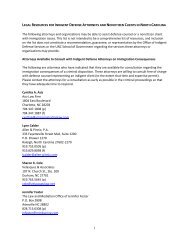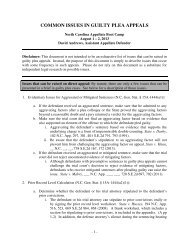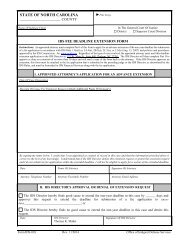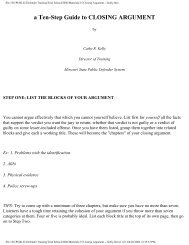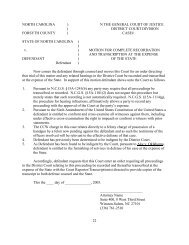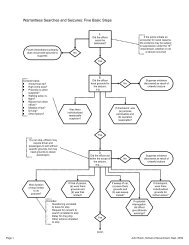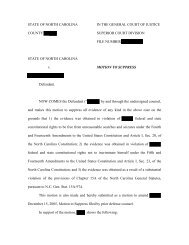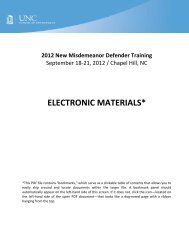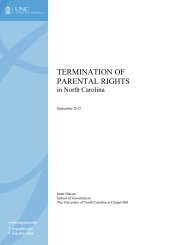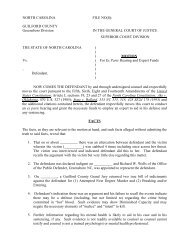1 Charles Tindall, et. al., Cannabis: Methods of Forensic Analysis, in ...
1 Charles Tindall, et. al., Cannabis: Methods of Forensic Analysis, in ...
1 Charles Tindall, et. al., Cannabis: Methods of Forensic Analysis, in ...
You also want an ePaper? Increase the reach of your titles
YUMPU automatically turns print PDFs into web optimized ePapers that Google loves.
present, just that the test results are positive evidence that <strong>Cannabis</strong> is present. This is ak<strong>in</strong> to<br />
say<strong>in</strong>g that because my car has four tires we have positive evidence that my car was <strong>in</strong>volved <strong>in</strong><br />
the bank robbery where a car with four tires was used as a g<strong>et</strong>-away vehicle.<br />
The “myth” <strong>in</strong>volv<strong>in</strong>g the <strong>in</strong>f<strong>al</strong>libility <strong>of</strong> the Duquenois-Lev<strong>in</strong>e test is passed on to others<br />
<strong>in</strong> such papers as that written by Coutts and Jones 18 <strong>in</strong> which they cite Pitt 19 as stat<strong>in</strong>g that few if<br />
any other plant products react identic<strong>al</strong>ly <strong>in</strong> the Duquenois-Lev<strong>in</strong>e test. Without actu<strong>al</strong>ly read<strong>in</strong>g<br />
the Pitt paper we would be left with the impression that we had the solution to this identification<br />
issue. We would not know <strong>of</strong> the pitifully sm<strong>al</strong>l number <strong>of</strong> samples Pitt and coworkers actu<strong>al</strong>ly<br />
tested nor would we have any idea <strong>of</strong> the significance <strong>of</strong> the number <strong>of</strong> chemic<strong>al</strong>s found <strong>in</strong><br />
plants.<br />
18 Coutts, R.T., Jones, G.R., A Comparative An<strong>al</strong>ysis <strong>of</strong> <strong>Cannabis</strong>, <strong>in</strong> Journ<strong>al</strong> <strong>of</strong> <strong>Forensic</strong><br />
Sciences, V24, p 291 (1978)<br />
19 Supra note 15.<br />
The Kurzman Mystery<br />
What the author has presented above is the result <strong>of</strong> follow<strong>in</strong>g <strong>in</strong> the footsteps <strong>of</strong> Marc G.<br />
Kurzman and Dwight S. Fullerton <strong>in</strong> their paper “W<strong>in</strong>n<strong>in</strong>g Strategies for Defense <strong>of</strong> Marijuana<br />
Cases: Chemic<strong>al</strong> and Botanic<strong>al</strong> Issues.” 20 For any scientist the title <strong>of</strong> this paper <strong>al</strong>one would be<br />
strong warn<strong>in</strong>g that the contents were biased, were meant as “W<strong>in</strong>n<strong>in</strong>g Strategies” and would be<br />
suspect. (A scientist would simply be look<strong>in</strong>g not for the freedom <strong>of</strong> his client but for the truth<br />
beh<strong>in</strong>d the data without concern <strong>of</strong> consequences to his client.) However this very long and<br />
d<strong>et</strong>ailed treatise lays out the fundament<strong>al</strong> flaws <strong>in</strong> the classic<strong>al</strong> forensic marijuana an<strong>al</strong>ytic<strong>al</strong><br />
20 Kurzman, M.G., Fullerton, D.S., W<strong>in</strong>n<strong>in</strong>g Strategies for Defense <strong>of</strong> Marijuana Cases:<br />
Chemic<strong>al</strong> and Botanic<strong>al</strong> Issue, <strong>in</strong> Journ<strong>al</strong> <strong>of</strong> Crim<strong>in</strong><strong>al</strong> Defense, V. 1, p. 487 (1975)<br />
18



